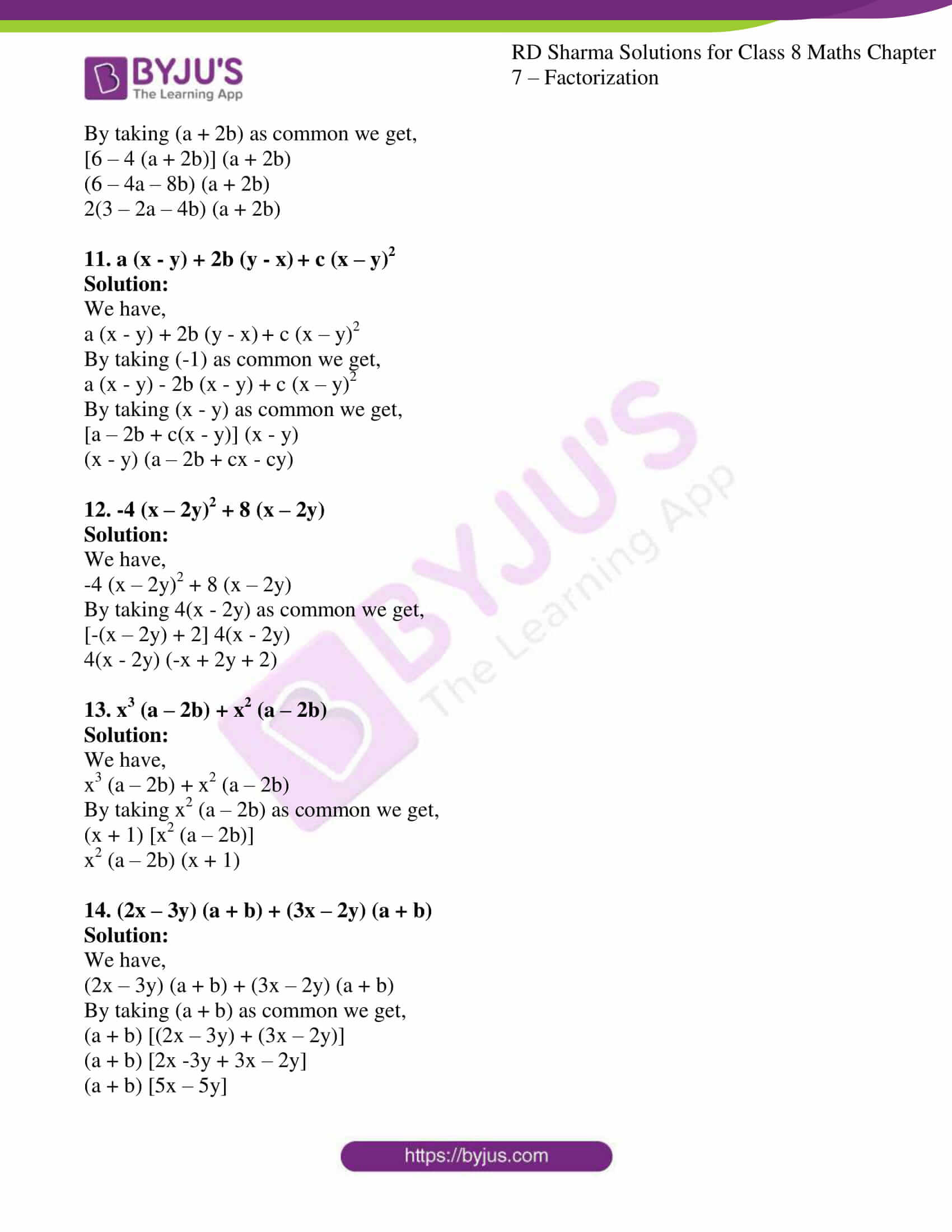Students can refer to RD Sharma Solutions for Class 8 Maths Exercise 7.3 Chapter 7 Factorization, which are available here. These solutions are solved in a step-by-step manner for a better understanding of the concepts, which helps students prepare for their exams with ease. Keeping this in mind, the expert tutors at BYJU’S have made this possible to help students crack difficult problems. Students can download the PDF of RD Sharma Solutions from the links provided below. Exercise 7.3 of Chapter 7 Factorization is based on the factorization of algebraic expressions when a binomial is a common factor.
RD Sharma Solutions for Class 8 Maths Exercise 7.3 Chapter 7 Factorization
Access Answers to RD Sharma Solutions for Class 8 Maths Exercise 7.3 Chapter 7 Factorization
EXERCISE 7.3 PAGE NO: 7.7
Factorize each of the following algebraic expressions:
1. 6x (2x – y) + 7y (2x – y)
Solution:
We have,
6x (2x – y) + 7y (2x – y)
By taking (2x – y) as common, we get,
(6x + 7y) (2x – y)
2. 2r (y – x) + s (x – y)
Solution:
We have,
2r (y – x) + s (x – y)
By taking (-1) as common, we get,
-2r (x – y) + s (x – y)
By taking (x – y) as common, we get,
(x – y) (-2r + s)
(x – y) (s – 2r)
3. 7a (2x – 3) + 3b (2x – 3)
Solution:
We have,
7a (2x – 3) + 3b (2x – 3)
By taking (2x – 3) as common, we get,
(7a + 3b) (2x – 3)
4. 9a (6a – 5b) – 12a2 (6a – 5b)
Solution:
We have,
9a (6a – 5b) – 12a2 (6a – 5b)
By taking (6a – 5b) as common, we get,
(9a – 12a2) (6a – 5b)
3a(3 – 4a) (6a – 5b)
5. 5 (x – 2y)2 + 3 (x – 2y)
Solution:
We have,
5 (x – 2y)2 + 3 (x – 2y)
By taking (x – 2y) as common, we get,
(x – 2y) [5 (x – 2y) + 3]
(x – 2y) (5x – 10y + 3)
6. 16 (2l – 3m)2 – 12 (3m – 2l)
Solution:
We have,
16 (2l – 3m)2 – 12 (3m – 2l)
By taking (-1) as common, we get,
16 (2l – 3m)2 + 12 (2l – 3m)
By taking 4(2l – 3m) as common we get,
4(2l – 3m) [4 (2l – 3m) + 3]
4(2l – 3m) (8l – 12m + 3)
7. 3a (x – 2y) – b (x – 2y)
Solution:
We have,
3a (x – 2y) – b (x – 2y)
By taking (x – 2y) as common, we get,
(3a – b) (x – 2y)
8. a2 (x + y) + b2 (x + y) + c2 (x + y)
Solution:
We have,
a2 (x + y) + b2 (x + y) + c2 (x + y)
By taking (x + y) as common, we get,
(a2 + b2 + c2) (x + y)
9. (x – y)2 + (x – y)
Solution:
We have,
(x – y)2 + (x – y)
By taking (x – y) as common, we get,
(x – y) (x – y + 1)
10. 6 (a + 2b) – 4 (a + 2b)2
Solution:
We have,
6 (a + 2b) – 4 (a + 2b)2
By taking (a + 2b) as common, we get,
[6 – 4 (a + 2b)] (a + 2b)(6 – 4a – 8b) (a + 2b)
2(3 – 2a – 4b) (a + 2b)
11. a (x – y) + 2b (y – x) + c (x – y)2
Solution:
We have,
a (x – y) + 2b (y – x) + c (x – y)2
By taking (-1) as common, we get,
a (x – y) – 2b (x – y) + c (x – y)2
By taking (x – y) as common, we get,
[a – 2b + c(x – y)] (x – y)(x – y) (a – 2b + cx – cy)
12. -4 (x – 2y)2 + 8 (x – 2y)
Solution:
We have,
-4 (x – 2y)2 + 8 (x – 2y)
By taking 4(x – 2y) as common, we get,
[-(x – 2y) + 2] 4(x – 2y)4(x – 2y) (-x + 2y + 2)
13. x3 (a – 2b) + x2 (a – 2b)
Solution:
We have,
x3 (a – 2b) + x2 (a – 2b)
By taking x2 (a – 2b) as common, we get,
(x + 1) [x2 (a – 2b)]
x2 (a – 2b) (x + 1)
14. (2x – 3y) (a + b) + (3x – 2y) (a + b)
Solution:
We have,
(2x – 3y) (a + b) + (3x – 2y) (a + b)
By taking (a + b) as common, we get,
(a + b) [(2x – 3y) + (3x – 2y)]
(a + b) [2x -3y + 3x – 2y]
(a + b) [5x – 5y]
(a + b) 5(x – y)
15. 4(x + y) (3a – b) + 6(x + y) (2b – 3a)
Solution:
We have,
4(x + y) (3a – b) + 6(x + y) (2b – 3a)
By taking (x + y) as common, we get,
(x + y) [4(3a – b) + 6(2b – 3a)]
(x + y) [12a – 4b + 12b – 18a]
(x + y) [-6a + 8b]
(x + y) 2(-3a + 4b)
(x + y) 2(4b – 3a)




Comments